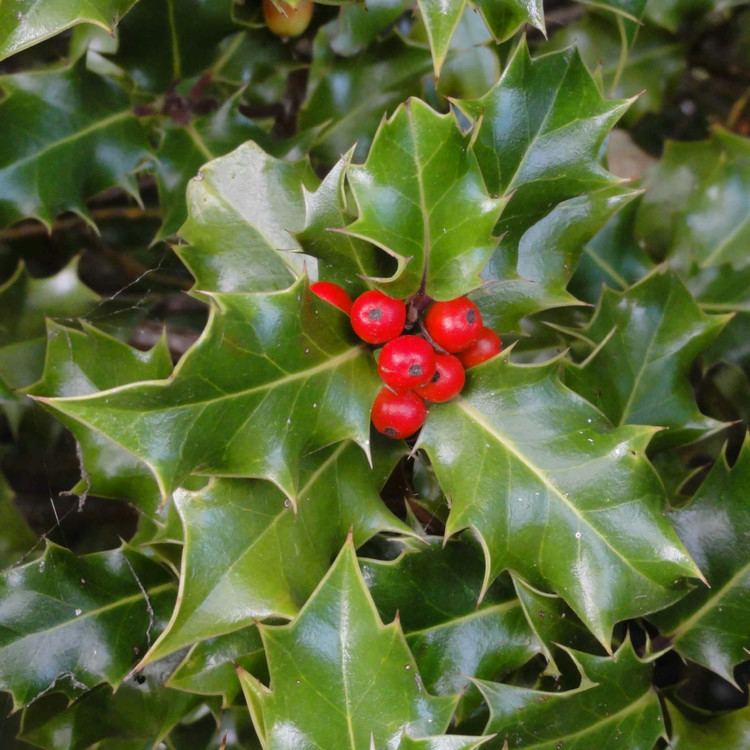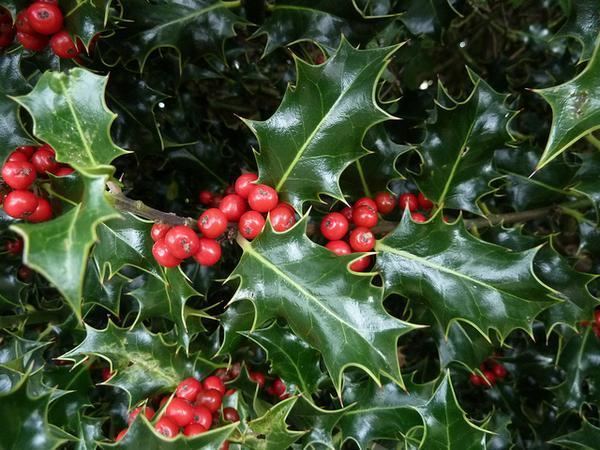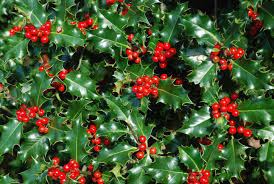Family Aquifoliaceae Scientific name Ilex aquifolium Rank Species | Genus Ilex Higher classification Holly | |
 | ||
Similar Holly, Viscum album, Butcher's‑broom, Poinsettia, Box | ||
Big plant nursery ilex aquifolium argentea marginata
Ilex aquifolium (holly, common holly, English holly, European holly, or occasionally Christmas holly), is a species of holly native to western and southern Europe, northwest Africa, and southwest Asia. I. aquifolium is the species familiar in Christmas decoration, and is regarded as the type species of the genus Ilex, which by association is also called "holly". It is a evergreen tree or shrub found, for example, in shady areas of forests of oak and in beech hedges. It has a great capacity to adapt to different conditions and is a pioneer species that repopulates the margins of forests or clearcuts.
Contents
- Big plant nursery ilex aquifolium argentea marginata
- Ilex aquifolium
- Description
- Distribution
- Ecology
- Cultivation
- Chemistry and toxicity medicinal and food uses
- Other uses
- References

As a tree, Christmas holly can exceed 10 m in height. It is usually found as a shrub or a small tree about 1 m tall with a straight trunk and pyramidal crown, which branches from the base. It grows slowly and does not usually fully mature due to grazing, cutting, or fire. It can live 500 years, but usually does not reach 100.

Ilex aquifolium
Description

Holly is an evergreen tree growing to 10–25 m tall with a woody stem as large as 40–80 cm, rarely 1 m or more, in diameter The leaves are 5–12 cm long and 2–6 cm broad; they are evergreen, lasting about five years, and are dark green on the upper surface and lighter on the underside, oval, leathery, shiny, and about 5 to 9 cm long. In the young and in the lower limbs of mature trees, the leaves have three to five sharp spines on each side, pointing alternately upward and downward, while leaves of the upper branches in mature trees lack spines.

The flowers are white, four-lobed, and pollinated by bees. Holly is dioecious, meaning that there are male plants and female plants. The sex cannot be determined until the plants begin flowering, usually between 4 and 12 years of age. In male specimens, the flowers are yellowish and appear in axillary groups. In the female, flowers are isolated or in groups of three and are small and white or slightly pink, and consist of four petals and four sepals partially fused at the base.

The fruit is a red drupe, about 6–10 mm in diameter, a bright red or bright yellow, which matures around October or November; at this time they are very bitter due to the ilicin content and so are rarely eaten until late winter after frost has made them softer and more palatable. They are eaten by rodents, birds and larger herbivores. Each fruit contains 3 to 4 seeds which do not germinate until the second or third spring. The fruit only appears on female plants, which require male plants nearby to fertilise them.
Distribution
Today, holly is found in western Asia and Europe in the undergrowth of oak forest and beech forest in particular, although at times it can form a dense thicket as the dominant species. It requires moist, shady environments, found within forests or in shady slopes, cliffs, and mountain gorges.
Along the west coast of the United States, from California to British Columbia, non-native English Holly has proved very invasive, quickly spreading into native forest habitat, where it thrives in shade and crowds out native species. It has been placed on the Washington State Noxious Weed Control Board's monitor list, and is a Class C invasive plant in Portland.
During the Cenozoic Era, the Mediterranean region, Europe, and northwest Africa had a wetter climate and were largely covered by laurel forests. Holly was a typical representative species of this biome, where many current species of the genus Ilex were present. With the drying of the Mediterranean Basin during the Pliocene, the laurel forests gradually retreated, replaced by more drought-tolerant sclerophyll plant communities. The modern Ilex aquifolium resulted from this change. Most of the last remaining laurel forests around the Mediterranean are believed to have died out approximately 10,000 years ago at the end of the Pleistocene.
Ecology
Holly is a rugged pioneer species that prefers relatively moist areas, and tolerates frost as well as summer drought. The plant is common in the garrigue and maquis and is also found in deciduous forest and oak forest.
Pure stands of hollies can grow into a labyrinth of vaults in which thrushes and deer take refuge, while smaller birds are protected among their spiny leaves. After the first frost of the season, holly fruits become soft and fall to the ground serving as important food for winter birds at a time of scarce resources.
The flowers are attractive as nectar sources for insects such as bees, wasps, flies, and small butterflies.
It is an invasive species on the West Coast of the United States and Hawaii.
Cultivation
Ilex aquifolium, the familiar holly of Christmas cards and wreaths, is widely grown in parks and gardens in temperate regions. Both male and female specimens must be grown together to ensure berries (drupes), which are produced only by female plants. Numerous cultivars have been selected, of which the following have gained the Royal Horticultural Society's Award of Garden Merit (RHS AGM):-
The hybrid Ilex x altaclerensis was developed at Highclere Castle in 1835, a cross between I. aquifolium and the tender species I. perado. The following cultivars have gained the RHS AGM:-
Chemistry and toxicity, medicinal and food uses
Holly berries contain alkaloids, caffeine, and theobromine and are generally regarded as toxic to humans, though their poisonous properties are overstated and fatalities almost unknown. Accidental consumption may occur by children or pets attracted to the bright red berries. The berries are emetic. This is described as being due to the drug ilicin, though caffeine and theobromine found throughout the plant are much more toxic, generally, to dogs and cats. The leaves of related plants are used to make a caffeine-rich beverage, yerba mate, which has caffeine in amounts equal to that of coffee. It is likely that I. aquifolium has equal amounts of caffeine in the leaves. It is described "The leaves of holly have been employed in the Black Forest as a substitute for tea"
Holly is rarely used medicinally, but is diuretic, relieves fevers, and has a laxative action.
Ilex aquifolium also contains saponins, theobromine (a xanthine), ilicin, caffeine, caffeic acid, and a yellow pigment, ilexanthin.
Other uses
Many hundreds of hybrids and cultivars have been developed for garden use, among them the very popular "Highclere holly", Ilex × altaclerensis (I. aquifolium × I. perado) and the "blue holly", Ilex × meserveae (I. aquifolium × I. rugosa). Hollies are often used for hedges; the spiny leaves make them difficult to penetrate, and they take well to pruning and shaping.
Between the thirteenth and eighteenth centuries, before the introduction of turnips, Ilex aquifolium was cultivated for use as winter fodder for cattle and sheep. Less spiny varieties of holly were preferred, and in practice the leaves growing near the top of the tree have far fewer spines making them more suitable for fodder.
Ilex aquifolium was once among the traditional woods for Great Highland bagpipes before tastes turned to imported dense tropical woods such as cocuswood, ebony, and African blackwood.
